The Monarch butterfly roosting sanctuaries in Mexico opened to tourists this weekend. The 13 protected areas that host tens of millions of eastern migrating Monarch butterflies each winter open their gates to the public in the latter half of November. That gives the butterflies, which typically arrive by Day of the Dead on November 2, time to settle in to their Oyamel tree roosts before the tourists show up.
A sojourn to the roosting sites is a bucket list item for many. I’ve been lucky to make the trip four times, and encourage anyone so inclined to do so. If and when you go, however, watch out for street dogs and keep an eye on your credit cards. While we won’t let it tarnish our memories of an amazing adventure, a dog bite resulting in rabies shots combined with credit card fraud put unpleasant footnotes on our recent trip. You would think us unlikely victims, given that my husband Robert Rivard and I both speak Spanish, lived in Central America for years and have traveled in Mexico for decades.
We had been planning the trip for months and even secured a special permit to visit the sanctuaries before their official November 18 opening from CEPANAF, the state commission on natural parks and fauna. My goal was to “see the Monarchs come home” for a book I’m writing. All previous visits had occurred in the spring, when the iconic insects start their months-long, multi-generation migration north.
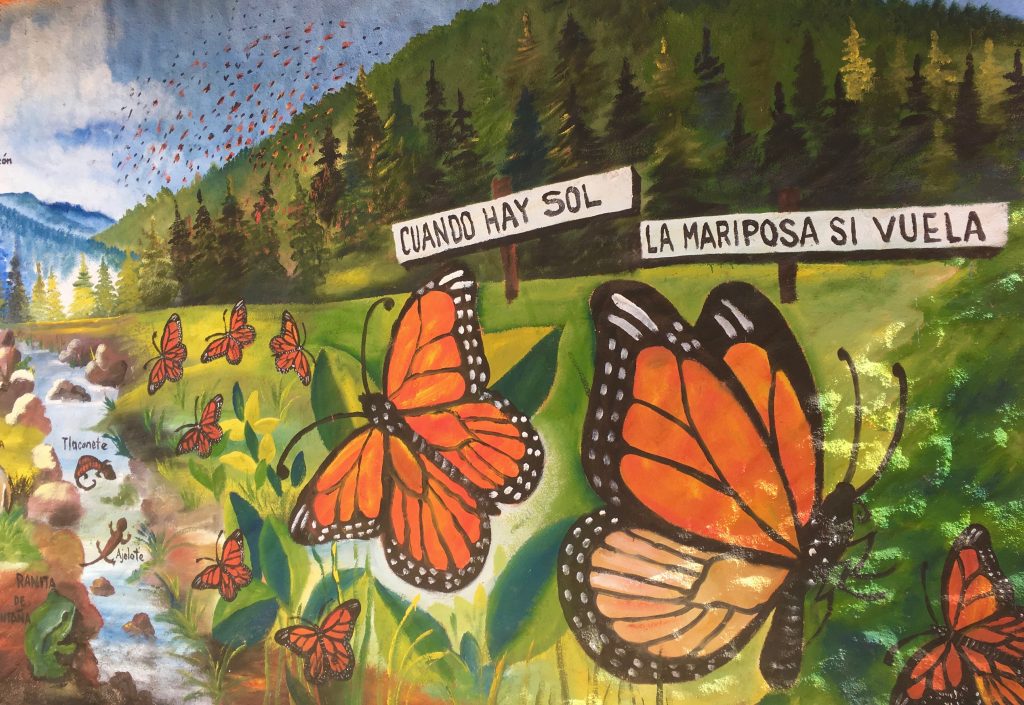
When there’s sun, the Monarchs fly. Mural at entrance of El Rosario sanctuary. Photo by Monika Maeckle
The return of the late, great 2017 population to the site of their ancestors’ departure in the Mexican mountains did not disappoint. We had an unforgettable visit to El Rosario, the most visited sanctuary. Our guide, Manual Cruz Posadas, led us on an hour-long climb up to 10,000 feet, where Monarchs gathered in tentative roosts. The folk art mural at the entrance of El Rosario accurately sums up the insects’ behaviour: “When the sun shines, the Monarchs fly; when it’s cloudy, the Monarchs rest.”
Legions of butterflies lilted from the trees each time the sun peaked from the clouds. Often they dipped to the ground for nectar or drops of dew. As soon as clouds shielded the sun, they instinctively gravitated to a designated tree. The Oyamels welcomed them with open limbs.
On Saturday, we vacated our room at the Casa de los Recuerdos in Zitácuaro, our base the first two nights, and took a taxi to the small town of Macheros, population 350. There, Ellen Sharp, co-owner of JM’s Butterfly B&B, arranged for her brother-in-law, Vicente Moreno Rojas, to guide us on an ambitious climb up Cerro Pelón. The “bald hill” was the site of the initial “discovery” of the roosting sites back in 1975.
We started on horseback and it wasn’t easy. A steep grade, rocky, slippery trail, and thin mountain air conspired to make the trek a serious challenge–even as Vicente prodded our horses. After an hour, we arrived at the Llano de Tres Gobernadores, a flat plain between two stands of Oyamel and pine forest. There, we enjoyed a picnic lunch packed by Moreno’s sister–ham sandwich, chips, apple and pedacito de chocolate, a small bite of chocolate.
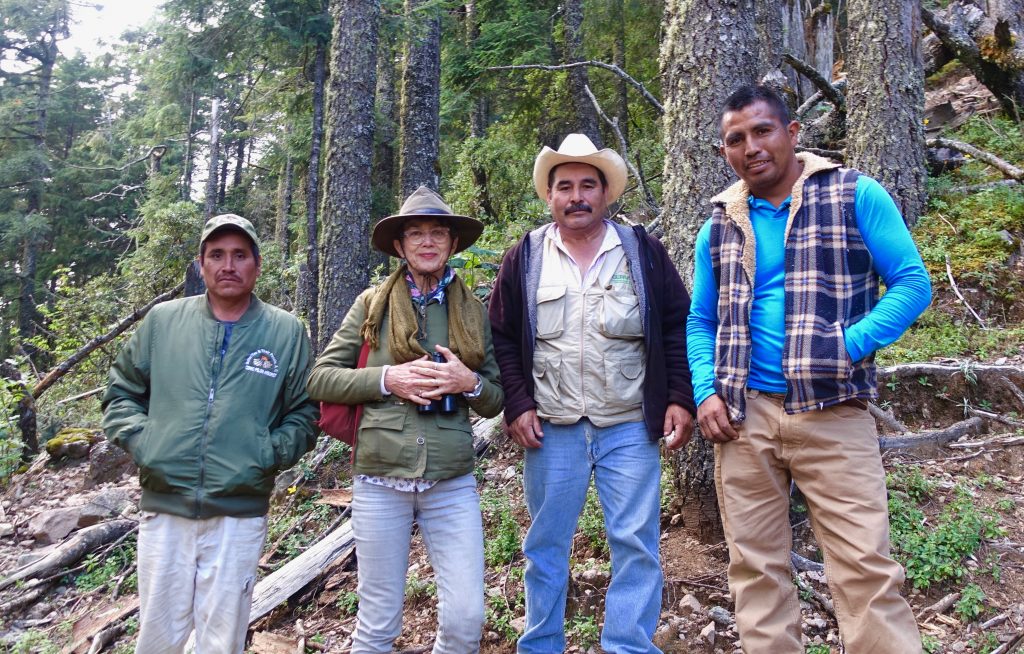
Butterflies & Their People arborist Francisco Moreno Hernandez, Monika Maeckle, CEPANAF Forest Ranger Javier Moreno and JM Butterfly B&B Guide Vicente Moreno Rojas. And yes, they’re all cousins. Photo by Robert Rivard
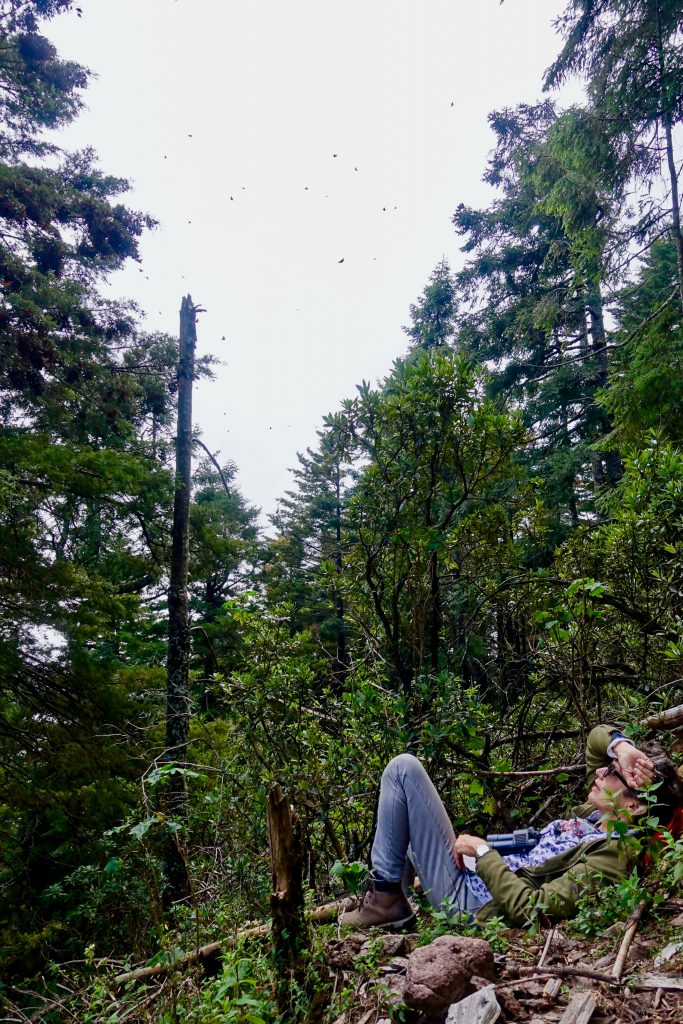
A dreamy day I’ll never forget in Cerro Pelón–Photo by Robert Rivard
National Geographic cover story headlined “Discovered: the Monarch’s Mexican Haven,” Urquhart bemoaned his advanced years and leaden feet. “Our hearts pounded…” he wrote. “The rather macabre though occurred to me: Suppose the strain proved too much?”
By late afternoon, we arrived at the trees the Monarchs had chosen. Seeing them saunter and flit against the cottony clouds and bright blue sky somehow reassured me. I sat on the ground, removed my hat, leaned back on an Oyamel stump and enjoyed the natural spectacle.
That evening, we savored a delicious trucha en papillote, trout cooked in paper. Sharp’s mother-in-law, Rosa Rojas Sanchez, 56, harvested the fish that afternoon from the Moreno family trout farm. She and her husband, five daughters and five sons, their spouses and offspring number 23, and comprise more than 6.5% of Machero’s population.
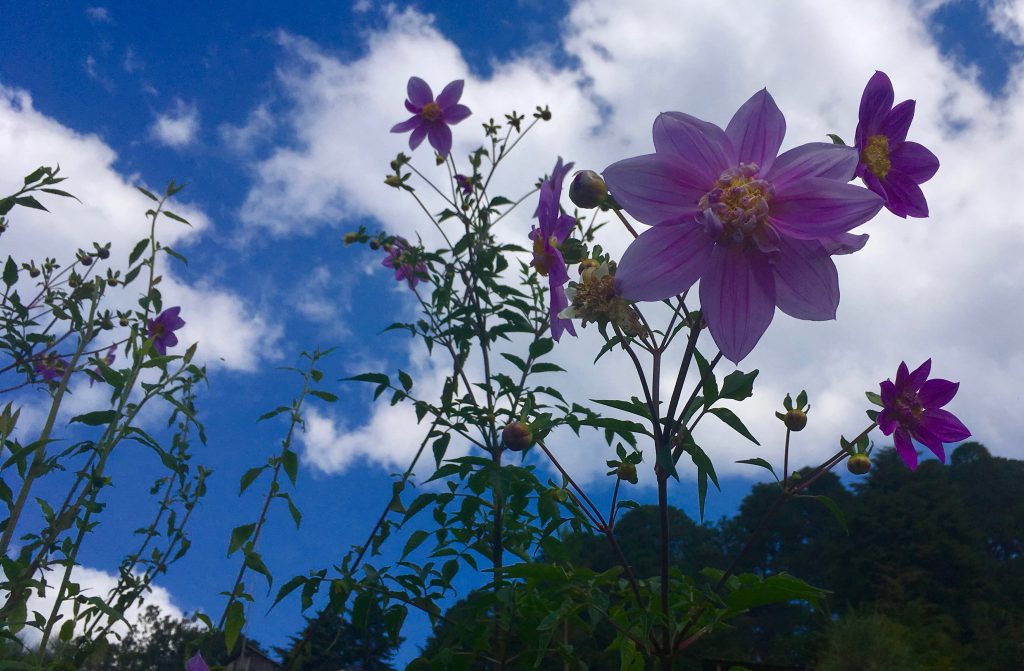
Enjoy the flowers in Macheros, but watch out for street dogs. Photo by Monika Maeckle
The next morning before returning to Zitácuaro to catch our bus to Mexico City, I ambled up the hill from the B&B while one of the Moreno sisters gave Bob a hot towel shave. A champagne-colored Chihuahua mix approached me nervously, yapping loudly. I shooed him away. The ruckus roused his sleeping friend, a 40-pound mutt with a short white coat and black spots. The dog rose from his street slumber, and with no provocation or warning, charged me, sinking his jaw into my left calf. YEOW!
I kicked the beast and he retreated. Then I remembered “the cave man trick” Bob taught me when we lived in El Salvador years ago, where encounters with canines de la calle were common. Lean down and grab a rock. If no rocks are available, PRETEND you have one. Stooping in such a manner seems to signal to dogs a potential stone coming their way. They almost always retreat. The cave man trick worked when the spotted dog approached me again.
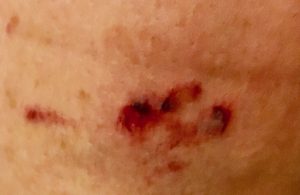
Dog bites are no fun. Use the caveman trick. Photo by Monika Maeckle
Sharp helped me dress the wound, which later measured 12 mm in a San Antonio hospital emergency room.
Researching and undergoing rabies shots consumed two days of my time upon my return. I agreed with the ER doctor who assessed the odds of me having rabies as “extremely low.” “But if you do,” he said, “it’s 100% fatal.”
I’m getting the shots. They’re not the horrid series of a dozen injections administered in the stomach with nine-inch needles of days past, however. That practice ended in the ’80s.
Now, the first round consists of four shots, including an intense injection of immunoglobulin into the actual dog bite. The thick liquid must be spread around the wound area—that is, the needle is inserted deeper than usual and moved in a circular motion under the skin—to deter the virus, if present, from migrating to the brain. All other shots are pretty routine.
Two da
No permanent harm done, except for an interesting future scar on my leg. New Visa cards arrived yesterday and my sixth shot in the rabies series of seven is set for Wednesday, the day before Thanksgiving. I am grateful to have access to good medical care and insurance. And to have had the magical experience of seeing the Monarchs come home.
Future Monarch roosting site visitors, I encourage you to go with a local. You’ll have an unforgettably authentic experience. Keep an eye on your credit cards and save all receipts. And don’t forget the cave man trick. Buen viaje.
Related posts:
- On the Monarch butterfly trail in Mexico: explosions, joy, and hasta la vista en Texas
- Commercially raised Monarch butterfly makes it to Mexico
- Coming soon? Grupo Mexico copper mine in heart of Monarch butterfly roosting sites
- Border wall at National Butterfly Center violates property rights and worse
- McAllen becomes second NWF Monarch Butterfly Champion City
- South Texas a great base for sojourn of bees, butterflies and birds
- Monarch Champion status not “just talk,” will change how San Antonio manages land
- What will happen to p pollinator advocacy under President Trump?
- Guidance on milkweed management confuses butterfly gardeners
- Endangered Species Act: wrong tool for monarch butterfly conservation?
- How to raise Monarch butterflies at home, Part 1
Like what you’re reading? Don’t miss a single post from the Texas Butterfly Ranch. Sign up for email delivery, like us on Facebook, or follow us on Twitter, @monikam.nbsp;

Thanks Monica, for this brief escaping to your world. I greatly enjoyed it. Although I will probably never make the journey to Mexico in my lifetime, seeing it through your eyes was wonderful. All special outings have moments to recall that are not always perfect but they add to the overall experience.
What a story! I’m so sorry to read about the rabies shots (as you for sure are!), but glad that you’re okay. Interesting about the credit card business also. I had the thrill of visiting El Rosario with Elder Hostel in the year 2000. That was a tough climb, but remains one of the most wonderous memories in my life. We were to visit another sanctuary in addition, but it was closed due to weather. I feel fortunate to have witnessed one of nature’s greatest miracles.
My goodness, Monika, quite the adventure! You do amaze and your devotion to the monarcas continues to inspire.
Oh, my! I wish you good health after your rabies adventure. Thanks for sharing your experience in the monarch sanctuary; I hope to visit someday.
Wow, what a story, indeed! Nice to know about the caveman trick but it’s especially great to read about your marvelous adventure. Keep ’em coming, my friend!
I was there one time the beginning of November. It was the year of the International Monarch Conference in Morealia. One of the things that impressed me was the wild Marigolds! The roadsides were orange with all in bloom. I wonder if you noticed that this year. I have a picture in my presentation materials of Marigolds as a serious weed in corn. I wold love that plant for my gardens here in Vietnam! They grow marigolds as a garden pant, but they are those ugly hybrid double flower. I wonder if a butterfly can even gather nectar from that flower.
Wow! What a story! I love the way you write. Your book will be great!
Sorry about the dog bite. Are you ok now?
I am so sorry to hear that you got bitten by a dog in Macheros and had to get the shots, Monika. The 36 of us who went with the IBBA a few weeks ago had a wonderful time visiting 3 preserves—and also stayed at JM’sButterfly B&B. For most of us, seeing the Monarchs in some of their over-wintering sites was a “bucket list” thing. So glad we all got to do this.